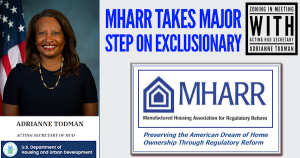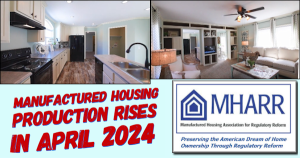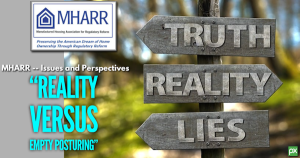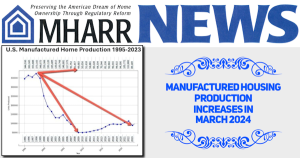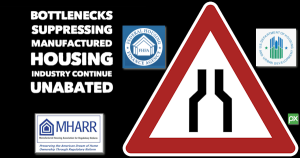“The ‘Woke’ War On Affordable Housing” MHARR – Issues and Perspectives, by Mark Weiss

“THE ‘WOKE’ WAR ON AFFORDABLE HOUSING”
The leaders of the “woke” mob – inside government and out — will never admit that they actually oppose affordable housing and homeownership for millions of lower and moderate-income Americans, including inherently affordable manufactured housing. But they do, with every means available to them. Naturally, they deny the truth of what they do to undermine affordable homeownership for lower-income Americans. In fact, they will tell you just the opposite – that they really care about lower-income people and that, through their various efforts, they simply want what (supposedly) is best for them. The comments filed by various “consumer” and “housing” organizations in the recent U.S. Department of Energy (DOE) rulemaking concerning manufactured housing “energy conservation” standards – and the standards themselves — are a good example. But it’s all a lie — a phony, fake narrative. The truth is that the “woke” elite hates affordable homeownership, at least for the lower and moderate-income Americans they use as political pawns.
The “woke” mob’s views regarding homeownership for lower and moderate-income Americans parallel its views on transportation. In the transportation arena, the “woke” crowd, to “save” the planet, ideally wants everyday Americans using government-provided “public” transit. Alternatively, if an American must have a private vehicle, they want it to be an outrageously costly “electric” vehicle. And just to prove the point, they have – and will continue — to do everything in their power to increase the cost of gasoline, to make the excessive cost of electric vehicles seem reasonable by comparison. But not to worry, they’ll help underwrite the ridiculous cost of that electric-powered fire hazard by tossing you a few nuggets in the form of subsidies or tax breaks that can be withdrawn any time the elites want.
So, how does this translate to the affordable housing arena, and how does the woke “elite” in government and beyond undermine the availability of affordable, private-sector homeownership? The first and most comprehensive tool that the “woke” elite deploy against affordable homeownership, and the Americans who need and require affordable homeownership, is restrictive and exclusionary zoning. You see, the woke elitists may claim to support lower and moderate-income Americans, but they do not want to actually live with them. They do not want less costly homes in their neighborhoods. They do not want lower income people living in their neighborhoods. They do not want their children going to school with “working class” kids, and they do not want to rub shoulders with the less affluent at the local wine shop. So, they make sure that affordable housing, like manufactured homes, are excluded from their neighborhoods through discriminatory and exclusionary zoning mandates. And, just like that, the “problem” is solved. They are free to preen and posture about affordable housing, without actually having to live in a community that offers affordable housing opportunities for everyone.
And what exactly does restrictive and exclusionary zoning do to the availability of affordable housing and homeownership? Years of research leaves no doubt whatsoever. Multiple studies have shown that restrictive and exclusionary zoning eliminates affordable housing and increases average home prices substantially. A 2016 Century Foundation study, titled “Understanding Exclusionary Zoning and its Impact on Concentrated Poverty,” states, in relevant part: “Exclusionary zoning … keeps affordable housing out of neighborhoods through land use and building code requirements. It’s a legal practice that has been used for decades to keep lower-income people — disproportionately racial minorities — out of wealthy and middle-class neighborhoods across the country. It can have a damaging effect in that it prevents these low-income families from having access to the education and employment opportunities typically found in wealthier neighborhoods.”
Consequently, it should surprise absolutely no one that discriminatory zoning mandates are routinely deployed to exclude lower cost manufactured housing and the lower and moderate-income Americans who rely on manufactured homes as a source of affordable homeownership. The excuses and rationalizations offered in support of such edicts are legion, but their exclusionary and discriminatory impacts are beyond debate.
How else does the “woke” elite undermine and destroy housing affordability? By increasing the cost of everything, including housing, via rampant inflation fueled, in substantial part, by excessive and unnecessary government spending. In May 2022, the Consumer Price Index (CPI) – the federal government’s measure of inflation within the economy — was 8.6% year-over-year, its highest level since 1981. This has both direct and indirect impacts on the housing market and housing affordability.
Inflation has a direct negative impact on homeownership by increasing the cost of housing itself, and also by fueling higher interest rates for home loans. Given the price sensitivity of lower and moderate-income homebuyers, moreover, this phenomenon disproportionately impacts consumers who would ordinarily seek access to the affordable housing market and manufactured housing in particular. Such direct impacts have been documented in research conducted by the National Association of Realtors (NAR). According to a recent press report: “The median price of a [site-built] home rose to $375,300, the highest ever recorded …. Compared with the prior month, the median price was up 4.5 percent. From a year ago, the median price is up 15 percent. Prices were up in all four major regions of the country. ‘The housing market is starting to feel the impact of sharply rising mortgage rates and higher inflation taking a hit on purchasing power,’ said Lawrence Yun, NAR’s chief economist.”
And while mainstream HUD Code manufactured housing still costs significantly less than a typical site-built home, neither manufactured homes per se, nor manufactured home consumer loans (particularly in the absence of any Duty to Serve support for manufactured home chattel loans) are immune from inflationary pressures within the broader economy. Consequently, with consumer-level inflation exceeding average wage growth in the United States, the cost of housing is rising faster than the ability of Americans to pay for and afford that housing. And, as is always the case, the greatest harm done by inflation is inflicted on those at the lower end of the economic ladder, who have less earning potential and can least afford disproportionate inflation-driven price increases.
Similarly, inflation has an indirect negative impact on access to homeownership. Quite simply, by increasing the cost of virtually all goods and services within the national economy at a faster and steeper rate than the growth of personal income, families are forced to pay more – and a greater proportion of their income – for non-housing related necessities. This inevitably leaves less income available for homeownership. At upper income levels, this cost “squeeze” may require homebuyers to limit purchases to smaller and less costly homes than they otherwise would consider. At lower income levels, however, inflation and skyrocketing costs for everyday living are more likely to drive consumers completely out of the homeownership market for extended periods of time, thus exacerbating homelessness and government dependence. This is reflected by a recent survey of American households conducted by the Federal Reserve Bank of New York. That survey showed that for the first time in at least a decade, fewer than half of current renters expect to eventually own a home — a clear reflection of how deeply the rise in prices has damaged the perceived affordability of homes. But don’t look for changes at the federal level to limit either the excessive spending or other policies that have spiked inflation since 2021. In fact, just the opposite is likely, particularly in advance of the November 2022 mid-term election and the 2024 presidential election.
Then there is the third “leg” of the “woke” trifecta – excessive and discriminatory manufactured housing “energy” regulation. While just a handful of states have adopted the 2018 version of the International Energy Conservation Code (IECC) – with most holding onto versions that are much older, and, therefore, more lenient and less costly – DOE plans to discriminatorily saddle the manufactured housing sector with energy standards based on the most recent 2021 iteration of the IECC. By DOE’s own calculations, this will increase the retail-level cost of manufactured homes by as much as $6,000.00, while excluding millions of lower and moderate-income Americans from the HUD Code market and from housing altogether. And this does not even begin to address added costs due to regulatory compliance costs, which have never even been estimated, because DOE has yet to propose a specific enforcement mechanism. Meanwhile, based on industry estimates, which include the effects of inflation on materials and supplies, the actual cost impact of the looming DOE standards could be well over $10,000.00 per home – which would decimate the manufactured housing market and the availability of inherently affordable homeownership for lower and moderate-income Americans.
But that didn’t bother the “woke” crowd, as dozens of “climate change” and supposed “affordable housing” organizations lined up during the rulemaking process to not only support high-cost DOE energy regulation, but to urge DOE to impose ultra-costly “untiered” energy standards to all manufactured housing across-the-board. Supposedly, these organizations did not want lower-income homebuyers to “suffer” from more lenient energy standards than would be applied to higher-price manufactured homes (never mind the much more lenient standards applied to much higher-cost site-built homes). They never bothered to explain, though, that far from “suffering” from lower energy standards, lower-income buyers would instead suffer from being totally excluded from the manufactured housing market and being unable to buy a home of their own as a result of the draconian cost of the untiered DOE energy standards. Far from “protecting” consumers, then, these organizations were actually lobbying to have Americans at the lower end of the economic ladder – people who currently could qualify to purchase a manufactured home – excluded from homeownership altogether and, therefore, more dependent on “big government” than ever.
Then there is DOE itself and its utter hypocrisy. In a June 9, 2022 propaganda news release touting its final manufactured housing energy standards, DOE totally ignores the massive purchase price increases those standards will cause, and the millions of lower-income Americans who will be denied all of the benefits of homeownership as a result. Instead, DOE brags about the “up to” $475 per year in utility bill savings that allegedly will flow from the new standards. Just one minor problem, though. For those excluded from homeownership by the cost of the new standards, there will be no savings, at all, per se. But even for those not totally excluded from homeownership, Moody’s Analytics reported days ago that Americans are paying an extra $460 every month just for life’s basic necessities, because of inflation now running at 8.6% per month. So, even for those not totally excluded by the new DOE standards, their paltry alleged “benefits” will be dwarfed by over $5,500 in added annual household inflation costs, courtesy of the same administration pushing the baseless and unnecessary DOE standards.
And, while we’re on the subject, let’s not forget the role of the ostensible national representative of “all segments” of the manufactured housing industry in this debacle. For years, and particularly during the sham DOE “negotiated rulemaking” process, the Manufactured Housing Institute (MHI) was all too happy to collaborate with energy special interests and DOE itself, in order to advance IECC-based, DOE federal energy standards. Indeed, MHI and virtually all of its members on the DOE Manufactured Housing Working Group (MHWG) (with one single abstention) voted in favor of the October 2014 negotiated rulemaking “Term Sheet” that was the precursor to the “final” DOE energy standards. MHARR, for its part, cast the one and only MHWG “no” vote on that Term Sheet. All of which begs the question, why would any national representative of an industry that thrives on – and is based on – purchase price affordability (as memorialized under federal law), go along with such a process and such a result. MHARR is studying all of this within a broader context and will soon publish the noteworthy results for the industry, consumers and energy stakeholders.
Far from promoting “equity,” then – or anything of the kind – both the DOE “final” energy standards and the “woke” organizations’ effort to impose the harshest standards across-the-board, were and are nothing more than a cynical, contemptuous attempt to balance a “climate change” agenda on the backs of hard-working yet lower-income families who will be excluded from homeownership as a result.
So, “wokesters,” spare us the claptrap. The truth is that your “equity” is as phony as a three-dollar bill. Far from helping the working poor and countless other lower and moderate-income Americans, you are their worst enemy, working to deprive them of life’s most essential elements, beginning with a safe, decent and affordable home.
Mark Weiss
MHARR is a Washington, D.C.-based national trade association representing the views and interests of independent producers of federally-regulated manufactured housing.
“MHARR-Issues and Perspectives” is available for re-publication in full (i.e., without alteration or substantive modification) without further permission and with proper attribution to MHARR.
“THE ‘WOKE’ WAR ON AFFORDABLE HOUSING”
The leaders of the “woke” mob – inside government and out — will never admit that they actually oppose affordable housing and homeownership for millions of lower and moderate-income Americans, including inherently affordable manufactured housing. But they do, with every means available to them. Naturally, they deny the truth of what they do to undermine affordable homeownership for lower-income Americans. In fact, they will tell you just the opposite – that they really care about lower-income people and that, through their various efforts, they simply want what (supposedly) is best for them. The comments filed by various “consumer” and “housing” organizations in the recent U.S. Department of Energy (DOE) rulemaking concerning manufactured housing “energy conservation” standards – and the standards themselves — are a good example. But it’s all a lie — a phony, fake narrative. The truth is that the “woke” elite hates affordable homeownership, at least for the lower and moderate-income Americans they use as political pawns.
The “woke” mob’s views regarding homeownership for lower and moderate-income Americans parallel its views on transportation. In the transportation arena, the “woke” crowd, to “save” the planet, ideally wants everyday Americans using government-provided “public” transit. Alternatively, if an American must have a private vehicle, they want it to be an outrageously costly “electric” vehicle. And just to prove the point, they have – and will continue — to do everything in their power to increase the cost of gasoline, to make the excessive cost of electric vehicles seem reasonable by comparison. But not to worry, they’ll help underwrite the ridiculous cost of that electric-powered fire hazard by tossing you a few nuggets in the form of subsidies or tax breaks that can be withdrawn any time the elites want.
So, how does this translate to the affordable housing arena, and how does the woke “elite” in government and beyond undermine the availability of affordable, private-sector homeownership? The first and most comprehensive tool that the “woke” elite deploy against affordable homeownership, and the Americans who need and require affordable homeownership, is restrictive and exclusionary zoning. You see, the woke elitists may claim to support lower and moderate-income Americans, but they do not want to actually live with them. They do not want less costly homes in their neighborhoods. They do not want lower income people living in their neighborhoods. They do not want their children going to school with “working class” kids, and they do not want to rub shoulders with the less affluent at the local wine shop. So, they make sure that affordable housing, like manufactured homes, are excluded from their neighborhoods through discriminatory and exclusionary zoning mandates. And, just like that, the “problem” is solved. They are free to preen and posture about affordable housing, without actually having to live in a community that offers affordable housing opportunities for everyone.
And what exactly does restrictive and exclusionary zoning do to the availability of affordable housing and homeownership? Years of research leaves no doubt whatsoever. Multiple studies have shown that restrictive and exclusionary zoning eliminates affordable housing and increases average home prices substantially. A 2016 Century Foundation study, titled “Understanding Exclusionary Zoning and its Impact on Concentrated Poverty,” states, in relevant part: “Exclusionary zoning … keeps affordable housing out of neighborhoods through land use and building code requirements. It’s a legal practice that has been used for decades to keep lower-income people — disproportionately racial minorities — out of wealthy and middle-class neighborhoods across the country. It can have a damaging effect in that it prevents these low-income families from having access to the education and employment opportunities typically found in wealthier neighborhoods.”
Consequently, it should surprise absolutely no one that discriminatory zoning mandates are routinely deployed to exclude lower cost manufactured housing and the lower and moderate-income Americans who rely on manufactured homes as a source of affordable homeownership. The excuses and rationalizations offered in support of such edicts are legion, but their exclusionary and discriminatory impacts are beyond debate.
How else does the “woke” elite undermine and destroy housing affordability? By increasing the cost of everything, including housing, via rampant inflation fueled, in substantial part, by excessive and unnecessary government spending. In May 2022, the Consumer Price Index (CPI) – the federal government’s measure of inflation within the economy — was 8.6% year-over-year, its highest level since 1981. This has both direct and indirect impacts on the housing market and housing affordability.
Inflation has a direct negative impact on homeownership by increasing the cost of housing itself, and also by fueling higher interest rates for home loans. Given the price sensitivity of lower and moderate-income homebuyers, moreover, this phenomenon disproportionately impacts consumers who would ordinarily seek access to the affordable housing market and manufactured housing in particular. Such direct impacts have been documented in research conducted by the National Association of Realtors (NAR). According to a recent press report: “The median price of a [site-built] home rose to $375,300, the highest ever recorded …. Compared with the prior month, the median price was up 4.5 percent. From a year ago, the median price is up 15 percent. Prices were up in all four major regions of the country. ‘The housing market is starting to feel the impact of sharply rising mortgage rates and higher inflation taking a hit on purchasing power,’ said Lawrence Yun, NAR’s chief economist.”
And while mainstream HUD Code manufactured housing still costs significantly less than a typical site-built home, neither manufactured homes per se, nor manufactured home consumer loans (particularly in the absence of any Duty to Serve support for manufactured home chattel loans) are immune from inflationary pressures within the broader economy. Consequently, with consumer-level inflation exceeding average wage growth in the United States, the cost of housing is rising faster than the ability of Americans to pay for and afford that housing. And, as is always the case, the greatest harm done by inflation is inflicted on those at the lower end of the economic ladder, who have less earning potential and can least afford disproportionate inflation-driven price increases.
Similarly, inflation has an indirect negative impact on access to homeownership. Quite simply, by increasing the cost of virtually all goods and services within the national economy at a faster and steeper rate than the growth of personal income, families are forced to pay more – and a greater proportion of their income – for non-housing related necessities. This inevitably leaves less income available for homeownership. At upper income levels, this cost “squeeze” may require homebuyers to limit purchases to smaller and less costly homes than they otherwise would consider. At lower income levels, however, inflation and skyrocketing costs for everyday living are more likely to drive consumers completely out of the homeownership market for extended periods of time, thus exacerbating homelessness and government dependence. This is reflected by a recent survey of American households conducted by the Federal Reserve Bank of New York. That survey showed that for the first time in at least a decade, fewer than half of current renters expect to eventually own a home — a clear reflection of how deeply the rise in prices has damaged the perceived affordability of homes. But don’t look for changes at the federal level to limit either the excessive spending or other policies that have spiked inflation since 2021. In fact, just the opposite is likely, particularly in advance of the November 2022 mid-term election and the 2024 presidential election.
Then there is the third “leg” of the “woke” trifecta – excessive and discriminatory manufactured housing “energy” regulation. While just a handful of states have adopted the 2018 version of the International Energy Conservation Code (IECC) – with most holding onto versions that are much older, and, therefore, more lenient and less costly – DOE plans to discriminatorily saddle the manufactured housing sector with energy standards based on the most recent 2021 iteration of the IECC. By DOE’s own calculations, this will increase the retail-level cost of manufactured homes by as much as $6,000.00, while excluding millions of lower and moderate-income Americans from the HUD Code market and from housing altogether. And this does not even begin to address added costs due to regulatory compliance costs, which have never even been estimated, because DOE has yet to propose a specific enforcement mechanism. Meanwhile, based on industry estimates, which include the effects of inflation on materials and supplies, the actual cost impact of the looming DOE standards could be well over $10,000.00 per home – which would decimate the manufactured housing market and the availability of inherently affordable homeownership for lower and moderate-income Americans.
But that didn’t bother the “woke” crowd, as dozens of “climate change” and supposed “affordable housing” organizations lined up during the rulemaking process to not only support high-cost DOE energy regulation, but to urge DOE to impose ultra-costly “untiered” energy standards to all manufactured housing across-the-board. Supposedly, these organizations did not want lower-income homebuyers to “suffer” from more lenient energy standards than would be applied to higher-price manufactured homes (never mind the much more lenient standards applied to much higher-cost site-built homes). They never bothered to explain, though, that far from “suffering” from lower energy standards, lower-income buyers would instead suffer from being totally excluded from the manufactured housing market and being unable to buy a home of their own as a result of the draconian cost of the untiered DOE energy standards. Far from “protecting” consumers, then, these organizations were actually lobbying to have Americans at the lower end of the economic ladder – people who currently could qualify to purchase a manufactured home – excluded from homeownership altogether and, therefore, more dependent on “big government” than ever.
Then there is DOE itself and its utter hypocrisy. In a June 9, 2022 propaganda news release touting its final manufactured housing energy standards, DOE totally ignores the massive purchase price increases those standards will cause, and the millions of lower-income Americans who will be denied all of the benefits of homeownership as a result. Instead, DOE brags about the “up to” $475 per year in utility bill savings that allegedly will flow from the new standards. Just one minor problem, though. For those excluded from homeownership by the cost of the new standards, there will be no savings, at all, per se. But even for those not totally excluded from homeownership, Moody’s Analytics reported days ago that Americans are paying an extra $460 every month just for life’s basic necessities, because of inflation now running at 8.6% per month. So, even for those not totally excluded by the new DOE standards, their paltry alleged “benefits” will be dwarfed by over $5,500 in added annual household inflation costs, courtesy of the same administration pushing the baseless and unnecessary DOE standards.
And, while we’re on the subject, let’s not forget the role of the ostensible national representative of “all segments” of the manufactured housing industry in this debacle. For years, and particularly during the sham DOE “negotiated rulemaking” process, the Manufactured Housing Institute (MHI) was all too happy to collaborate with energy special interests and DOE itself, in order to advance IECC-based, DOE federal energy standards. Indeed, MHI and virtually all of its members on the DOE Manufactured Housing Working Group (MHWG) (with one single abstention) voted in favor of the October 2014 negotiated rulemaking “Term Sheet” that was the precursor to the “final” DOE energy standards. MHARR, for its part, cast the one and only MHWG “no” vote on that Term Sheet. All of which begs the question, why would any national representative of an industry that thrives on – and is based on – purchase price affordability (as memorialized under federal law), go along with such a process and such a result. MHARR is studying all of this within a broader context and will soon publish the noteworthy results for the industry, consumers and energy stakeholders.
Far from promoting “equity,” then – or anything of the kind – both the DOE “final” energy standards and the “woke” organizations’ effort to impose the harshest standards across-the-board, were and are nothing more than a cynical, contemptuous attempt to balance a “climate change” agenda on the backs of hard-working yet lower-income families who will be excluded from homeownership as a result.
So, “wokesters,” spare us the claptrap. The truth is that your “equity” is as phony as a three-dollar bill. Far from helping the working poor and countless other lower and moderate-income Americans, you are their worst enemy, working to deprive them of life’s most essential elements, beginning with a safe, decent and affordable home.
Mark Weiss
MHARR is a Washington, D.C.-based national trade association representing the views and interests of independent producers of federally-regulated manufactured housing.
“MHARR-Issues and Perspectives” is available for re-publication in full (i.e., without alteration or substantive modification) without further permission and with proper attribution to MHARR.





